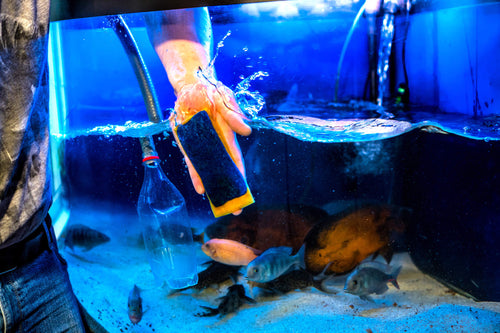Index Surge: Amplifying Your Insights
Stay updated with the latest trends and news across various industries.
Aquarium Care: Don't Let Your Fish School You on Maintenance
Unlock the secrets of flawless aquarium care and ensure your fish thrive—don't let them outsmart you on maintenance!
Essential Aquarium Maintenance Tips for Healthy Fish
Maintaining a healthy aquarium is vital for the well-being of your fish. Regularly monitoring water conditions such as pH, ammonia, and nitrite levels is essential to prevent toxic buildups. Water changes should be performed weekly, removing 10-15% of the water to help keep the environment clean. Additionally, using a reliable filtration system will aid in maintaining water quality. Remember that overfeeding can lead to waste accumulation, so stick to a feeding schedule and only offer what your fish can consume in a few minutes.
Another crucial aspect of aquarium maintenance is algae control. Regularly check for algae growth and use a scrubber or algae eater to maintain a balanced ecosystem. It's also important to clean decorations and substrate occasionally to prevent debris buildup. Lastly, monitor your fish for any signs of stress or disease; early detection can lead to a healthier aquarium. By following these essential aquarium maintenance tips, you can ensure a thriving environment for your fish.

Common Mistakes New Aquarium Owners Make
One of the most common mistakes new aquarium owners make is rushing the cycling process of their aquarium. Many beginners are eager to add fish to their new tank without understanding the importance of establishing beneficial bacteria that break down harmful toxins. This process, known as cycling, allows for a stable environment where fish can thrive. Failing to cycle the aquarium properly can lead to toxic ammonia levels, resulting in stress or even death for the fish. It is crucial to wait at least 4 to 6 weeks before introducing any fish to the tank, ensuring the necessary bacteria have time to build up.
Another frequent pitfall involves overfeeding fish, which can cause several problems for both the inhabitants and the aquarium's ecosystem. New owners often believe that feeding fish more will promote growth and health, but in reality, excess food can lead to poor water quality and an increase in harmful waste. It's advisable to feed fish only what they can consume in a few minutes, once or twice a day. Keeping a close eye on your aquarium can help you understand the right amount of food needed and prevent the overfeeding mistake that many new enthusiasts encounter.
Is Your Aquarium Setup Fish-Friendly? Key Signs to Look For
When setting up an aquarium, it’s crucial to ensure that your environment is conducive to the well-being of your aquatic inhabitants. One of the primary signs that your aquarium is fish-friendly is the presence of stable water parameters. Regularly testing for pH, ammonia, nitrite, and nitrate levels will help maintain a healthy habitat. Additionally, observe how your fish behave; signs of stress, such as hiding frequently or erratic swimming, can indicate that their environment is not suitable.
Another key indicator of a fish-friendly aquarium is the presence of adequate space and hiding spots. An overcrowded tank can lead to aggressive behavior and increased competition for resources, so it's essential to follow the recommended stocking levels for your fish species. Incorporating plants, rocks, and caves can provide shelter and reduce stress levels. Keep an eye on your aquarium's filtration system as well; a proper filter not only keeps the water clean but also maintains oxygen levels, creating a more hospitable environment for your aquatic pets.